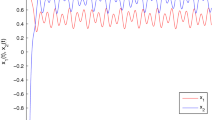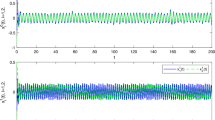Abstract
The uniformly pseudo-projection-anti-monotone (UPPAM) networks can jointly cover almost all of the known recurrent neural network individuals. In this paper, we develop some convergence theory for the UPPAM networks when the time is discrete. The results for convergence to an equilibrium as well as to the ring whose period is not greater than 2 for the UPPAM networks do not require the connective weight matrices to be symmetric anymore, which is the basic requirements for many existing dynamics analysis for the discrete-time recurrent neural network models. In addition, these theorems contain the least constraints, give the general determinate methods of convergence for UPPAM networks, and can be verified and utilized very easily. The study shows that the approach adopted in the present paper is powerful, particularly in the sense of unifying, simplifying and extending the currently existing various dynamics results for discrete-time RNNs.





Similar content being viewed by others
References
Liu Q, Cao J, Chen G (2010) A novel recurrent neural network with finite-time convergence for linear programming. Neural Comput 22(11):2962–2978
Yang Y, Cao J (2008) A feedback neural network for solving convex constraint optimization problems. Appl Math Comput 201(1–2):340–350
Liu Q, Dang C, Cao J (2010) A novel recurrent neural network with one neuron and finite-time convergence for \(k\)-winners-take-all operation. IEEE Trans Neural Netw 21(7):1140–1148
Liu Q, Cao J (2010) A recurrent neural network based on projection operator for extended general variational inequalities. IEEE Trans Syst Man Cybern Part B 40(3):928–938
Liu Q, Cao J (2011) Global exponential stability of discrete-time recurrent neural network for solving quadratic programming problems subject to linear constraints. Neurocomputing 74(17):3494–3501
Almeida LB (1989) Backpropagation in perceptrons with feedback. In: Eckmiller R, vd Malsburg C (eds) Neural Computers. Springer Study Edition, vol 41. Springer, Berlin, Heidelberg, pp 199–208
Anderson JA, Silverstein JW, Ritz SA, Jones RS (1977) Distinctive features, categorical perception, and probability learning: some applications of a neural model. Psychol Rev 84(5):413
Banzhaf W (1987) Towards continuous models of memory. In: Proceedings IEEE 1st International Conference Neural Nets, San iego, pp 223–230
Bouzerdoum A, Pattison TR (1993) Neural network for quadratic optimization with bound constraints. IEEE Trans Neural Netw 4(2):293–304
Chen ZY, Kwong CP, Xu ZB (1995) Multiple-valued feedback and recurrent correlation neural networks. Neural Comput Appl 3(4):242–250
Chiueh TD, Goodman RM (1991) Recurrent correlation associative memories. IEEE Trans Neural Netw 2(2):275–284
Forti M, Tesi A (1995) New conditions for global stability of neural networks with application to linear and quadratic programming problems. IEEE Trans Circuits Syst I Fundam Theory Appl 42(7):354–366
Goles-Chacc E, Fogelman-Soulié F, Pellegrin D (1985) Decreasing energy functions as a tool for studying threshold networks. Discrete Appl Math 12(3):261–277
Hopfield JJ (1982) Neural networks and physical systems with emergent collective computational abilities. Proc Natl Acad Sci 79(8):2554–2558
Hopfield JJ, Tank DW et al (1986) Computing with neural circuits- a model. Science 233(4764):625–633
Hui S, Zak SH (1992) Dynamical analysis of the brain-state-in-a-box (bsb) neural models. IEEE Trans Neural Netw 3(1):86–94
Hui S, Zak SH (1994) Dynamical analysis of the brain-state-in-a-box (bsb) neural models. IEEE Trans Neural Netw 3(1):86–94
Kosko B (1988) Bidirectional associative memories. IEEE Trans Syst Man Cybern 18(1):49–60
Little WA (1974) The existence of persistent states in the brain. Springer, US
Marcus C, Westervelt R (1989) Dynamics of iterated-map neural networks. Phys Rev A 40(1):501
Perez-Ilzarbe MJ (1998) Convergence analysis of a discrete-time recurrent neural network to perform quadratic real optimization with bound constraints. IEEE Trans Neural Netw 9(6):1344–1351
Peterson C (1987) A mean field theory learning algorithm for neural networks. Complex Syst 1:995–1019
Pineda FJ (1987) Generalization of back-propagation to recurrent neural networks. Phys Rev Lett 59(19):2229
Qiao C, Xu ZB (2007) New critical analysis on global convergence of recurrent neural networks with projection mappings. Adv Neural Netw ISNN 2007:131–139
Qiao H, Peng J, Xu ZB, Zhang B (2003) A reference model approach to stability analysis of neural networks. IEEE Trans Syst Man Cybern Part B (Cybernetics) 33(6):925–936
Seiler G, Nossek JA (1993) Winner-take-all cellular neural networks. IEEE Trans Circuits Syst II Analog Digital Signal Process 40(3):184–190
Si J, Michel AN (1995) Analysis and synthesis of a class of discrete-time neural networks with multilevel threshold neurons. IEEE Trans Neural Netw 6(1):105–116
Xu Z, Kwong C (1995) Global convergence and asymptotic stability of asymmetric hopfield neural networks. J Math Anal Appl 191(3):405–427
Xu ZB, Hu GQ, Kwong CP (1996) Asymmetric hopfield-type networks: theory and applications. Neural Netw 9(3):483–501
Xu ZB, Qiao C (2011) Towards a unified recurrent neural network theory: the uniformly pseudo-projection-anti-monotone net. Acta Math Sin 27(2):377–396
Yi Z, Heng PA, Fung PF (2000) Winner-take-all discrete recurrent neural networks. IEEE Trans Circuits Syst II Analog Digital Signal Process 47(12):1584–1589
Yi Z, Tan KK (2004) Multistability of discrete-time recurrent neural networks with unsaturating piecewise linear activation functions. IEEE Trans Neural Netw 15(2):329–336
Mccullagh P (2002) Quasi-symmetry and representation theory. Annales de la faculté des sciences de Toulouse Sér 11(4):541–561
Author information
Authors and Affiliations
Corresponding author
Additional information
Publisher's Note
Springer Nature remains neutral with regard to jurisdictional claims in published maps and institutional affiliations.
This research was supported by NSFC Nos. 11471006 and 11101327, National Science and Technology Cooperation Program of China (No. 2015DFA81780), the Fundamental Research Funds for the Central Universities (No. xjj2017126) and was partly Supported by HPC Platform, Xi’an Jiaotong University.
Rights and permissions
About this article
Cite this article
Qiao, C., Guo, B. On the Flexible Dynamics Analysis for the Unified Discrete-Time RNNs. Neural Process Lett 50, 1755–1771 (2019). https://doi.org/10.1007/s11063-018-9959-5
Published:
Issue Date:
DOI: https://doi.org/10.1007/s11063-018-9959-5




